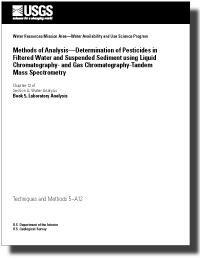Methods of Analysis—Determination of Pesticides in Filtered Water and Suspended Sediment using Liquid Chromatography- and Gas Chromatography-Tandem Mass Spectrometry
Links
- Document: Report (2 MB pdf) , HTML , XML
- Data Release: USGS Data Release - A multiresidue method for the analysis of pesticides in water using solid-phase extraction with gas and liquid chromatography-tandem mass spectrometry (ver. 2.0, April 2023)
- Download citation as: RIS | Dublin Core
Abstract
The widespread application of pesticides in agricultural and urban areas leads to their presence in surface waters. Presence of these biologically active chemicals in environmental waters potentially has adverse effects on nontarget organisms. To better understand the environmental fate of these contaminants, a robust method to capture chemicals with wide-ranging physicochemical properties has been developed. The method was developed by the U.S. Geological Survey’s Organic Chemistry Research Laboratory to monitor pesticides, pesticide degradates, and other agrochemicals in environmental surface waters throughout the country. The analysis involves a multiresidue method to determine 183 pesticides and pesticide degradates in filtered water samples and 178 pesticides and pesticide degradates in paired suspended sediment samples. After the filtration of whole water, contaminants are individually measured in the filtered water and the collected suspended sediment. Filtered water is extracted via solid-phase extraction, whereas suspended sediment is extracted using an ultrasonication, solid-liquid extraction. Samples are analyzed by liquid chromatography-tandem mass spectrometry using an electrospray ionization source in positive and negative modes and analyzed by gas chromatography-tandem mass spectrometry using an advanced electron ionization source in positive mode. Instrument parameters were optimized for the highest sensitivity, and at least two transitions (quantifier and qualifier) were monitored for each analyte.
Recoveries in test filtered water (n=9; 183 analytes) from the American River, California, and suspended sediment (n=9; 178 analytes) samples fortified at 15 nanograms per liter (ng/L) ranged from 70.1 to 121.0 and 71.1 to 117.0 percent in water and suspended sediment filter samples, respectively. Method detection limits of pesticides and pesticide degradates ranged from 0.5 to 10.6 ng/L in water and 0.7 to 11.8 ng/L in suspended sediment filters. Reporting limits were 1.1–21.1 ng/L and 1.5–23.7 ng/L in water and filter samples, respectively. The developed method is applied to surface-water samples for the analysis of pesticides, pesticide degradates, and other agrochemicals.
Suggested Citation
Gross, M.S., Sanders, C.J., De Parsia, M.D., and Hladik, M.L., 2024, Methods of analysis—Determination of pesticides in filtered water and suspended sediment using liquid chromatography- and gas chromatography-tandem mass spectrometry: U.S. Geological Survey Techniques and Methods, book 5, chap. A12, 33 p., https://doi.org/10.3133/tm5A12.
ISSN: 2328-7055 (online)
Table of Contents
- Abstract
- Introduction
- Purpose and Scope
- Methods of Study
- Analytical Method
- Method Performance
- Data Handling
- Summary
- Acknowledgments
- References Cited
| Publication type | Report |
|---|---|
| Publication Subtype | USGS Numbered Series |
| Title | Methods of analysis—Determination of pesticides in filtered water and suspended sediment using liquid chromatography- and gas chromatography-tandem mass spectrometry |
| Series title | Techniques and Methods |
| Series number | 5-A12 |
| DOI | 10.3133/tm5A12 |
| Publication Date | January 31, 2024 |
| Year Published | 2024 |
| Language | English |
| Publisher | U.S. Geological Survey |
| Publisher location | Reston, VA |
| Contributing office(s) | California Water Science Center |
| Description | Report: vi, 33 p.; Data Release |
| Online Only (Y/N) | Y |


